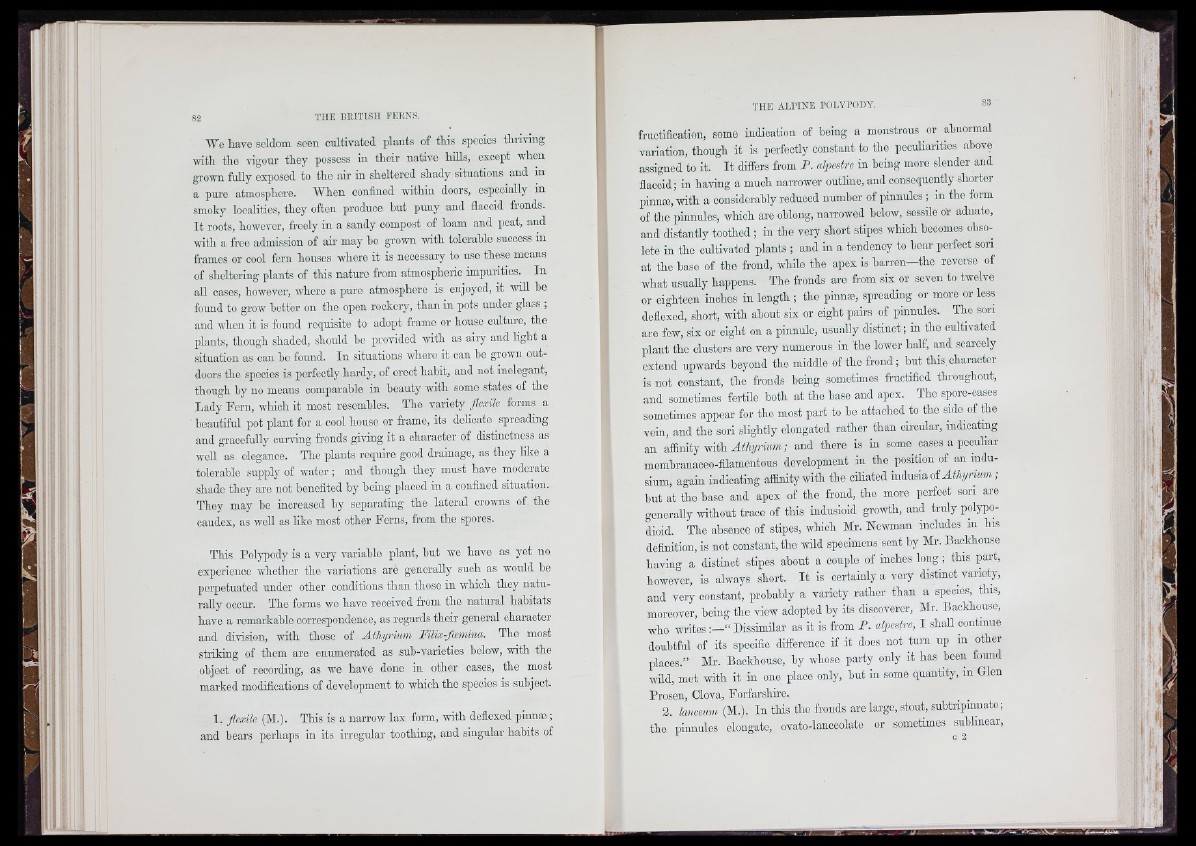
Wo have seldom seen cultivated plants of this species thriving
udth tho vigour they possess in thoir native hills, except when
grown fully exposed to tho air in sheltered shady situations and in
a pure atmosphere. When confined within doors, especially in
smoky looalitios, they often produce hut puny and flaooid fronds.
I t roots, however, freely in a sandy compost of loam and peat, and
wdth a free admission of air may he grown with tolorahlo success in
frames or cool fern houses whore it is necessary to uso thoso means
of sheltering plants of this nature from atmospheric impurities. In
aU cases, however, whoro a pure atmosphere is enjoyed, it wül ho
found to grow better on tho open rockery, than in pots under glass ;
and w’hon it is found requisito to adopt frame or house culture, the
plants, though shaded, should ho provided with as airy and light a
situation as can ho found. Iu situations whoro it can ho grown outdoors
tho species is porfootly hardy, of erect habit, and not inelegant,
though by no moans comparable in beauty Avitb some states of the
Lady Fern, Avhioh it most resembles. Tho variety flexile forms a
beautiful pot plant for a cool house or frame, its delicate spreading
and gracefully curving fronds giving it a character of distinctness as
well as elegance. The plants require good drainage, as they like a
tolerable supply of water ; and though they must have moderate
shade they are not honofitod by being placed in a confined situation.
They may bo increased by separating the lateral crowns of tho
caudex, as wcU as like most other Ferns, from tho spores.
This Pol}q)ody is a very variable plant, but wc have as yet no
experience AA'hetber the variations aré generally such as would be
perpetuated under other conditions than those in wdiich they naturally
occur. The forms we have received from tho natural habitats
have a remarkable correspondence, as regards thoir general character
and division, with thoso of Athyrium Filix-fcemina. The most
striking of them are enumerated as sub-varieties below, with the
object of recording, as we have done in other cases, tho most
marked modifications of development to which the species is subject.
1. flexile (INI.). This is a narrow lax form, with doflexed pinnæ ;
and hears perhaps in its irregular toothing, and singular habits of
fructification, some indication of being a monstrous or abnormal
variation, though it is perfectly constant to tho peculiarities above
assigned to it. I t differs from P . alpestre in boing moro slender and
flaccid; in having a much narrower outline, and consequently shorter
pinnæ,’with a considerably reduced number of pinnules ; in tbe form
of the pinnules, which arc oblong, narrowed below, sessile or adnate,
and distantly toothed ; in the very short stipes which becomes obsolete
in the cultivated plants ; and in a tendency to bear perfect son
a t the base of tho frond, whilo the apex is barren—the reverse of
what usually happens. Tho fronds aro from six or seven to twelve
or oightoon inches in length ; tho pinnæ, spreading or more or less
doflexed, short, with about six or eight pairs of pinnules. Tho son
arc few, six or eight on a pinnule, usually distinct ; m the cultivated
plant tho clusters are very numerous in the lower half, and scarcely
extend upwards beyond the middle of tho frond ; but this character
is not constant, the fronds boing sometimes fructified tliroughout,
and sometimes fertile both at the base and apox. Tho spore-oases
sometimes appoar for the most part to he attached to the side of the
vein, and the sori slightly elongated rather than circular, indicating
an affinity with At/ii/ni«»; and there is in some cases a peculiar
membranaoeo-filamentous development in the position of an indusium,
again indicating affinity with the ciHatcd indusia of A ;
but at the base and apox of the frond, the more perfect son are
generally without trace of this indusioid growth, and truly polypo-
dioid. The absence of stipes, which Mr. Neivmau includes in his
definition, is not constant, the wild specimens sent by Mr. Backhouse
having a distinct stipes about a couple of inches long ; this part,
however, is always short. I t is certainly a very distinct variety,
and very constant, probably a variety rather tlian a species, tins,
moreover, boing the view adopted by its discoverer, Mr. Backhouse,
who writes “ Dissimilar as it is from P. alpestre, I shall continue
doubtful of its specific differonoo if it does not turn up in other
places.” Mr. Backliouso, by whose party only it bas been found
wild, met with it in one place only, but in some quantity, in Glen
Prosen, Clova, Forfarsbirc.
2. lancemn (M.). In this tho fronds aro largo, stout, subtripinnate;
the pinnules elongate, ovato-lanoeolate or sometimes suhlinear.
i .M
l i t e